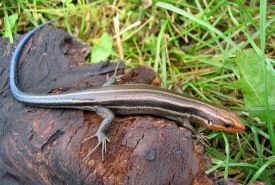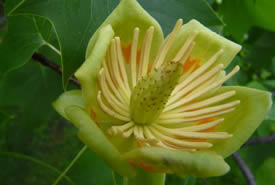Essex Forests and Wetlands Natural Area

The five-lined skink, Ontario's only lizard species (Photo by Ryan M. Bolton)
Why this place is important
Located in the southwest corner of Ontario lies a rich collection of Carolinian forests, wetlands, prairies and Lake Erie shoreline. NCC’s Essex Forests and Wetlands Natural Area is an area of important biodiversity bordered by Lake Erie to the south, the Detroit River to the west and Lake St. Clair to the north.
The Essex Forests and Wetlands Natural Area is part of Carolinian Canada — a region that supports over 2,200 plant species, including 70 types of trees and over half of Canada’s bird species. The natural area’s 90,031 hectares (222,466 acres) are home to more than 75 species at risk, 11 of which are globally rare. The area also includes Provincially Significant Wetlands, Areas of Natural and Scientific Interest and several Important Bird Areas.
What NCC is doing here
The Nature Conservancy of Canada (NCC), along with our partners, have conserved 344 hectares (855 acres) in the Essex area since beginning our work here in 2000. Of that, 130 hectares (321 acres) have been restored to natural habitat.
At NCC’s Oxley Poison Sumac Swamp, staff conduct yearly stewardship and monitoring. In 2015, we completed a wetland restoration project, and today NCC staff continue to combat invasive species, such as garlic mustard and phragmites, found here.
In 2018, we ramped up our work in the area by opening a new office in southwest Windsor and hired a dedicated conservation coordinator for the area. Today we are making considerable progress toward building partnerships and determining what additional conservation tools we might be able to bring to this agricultural heartland.
Looking ahead, we are concentrating our conservation efforts in four areas: the Ojibway prairie complex, Big Creek, Lebo Creek and Cedar Creek. Developing and maintaining successful, mutually beneficial partnerships with local conservation organizations, landowners and residents is our top priority.
What lives here
These are some of the significant and at-risk species found in this natural area:
Reptiles, amphibians and turtles
- Butler's gartersnake (endangered)
- eastern foxsnake - Carolinian population (endangered)
- eastern hog-nosed snake (threatened)
- five-lined skink - Carolinian population (endangered)
- massasauga - Carolinian population (endangered)
- milksnake (special concern)
- queensnake (endangered)
- Blanding's turtle (threatened)
- eastern musk turtle (special concern)
- northern map turtle (special concern)
- snapping turtle (special concern)
- spiny softshell turtle (threatened)
Birds
- Acadian flycatcher (endangered)
- bald eagle (not at risk)
- bank swallow (threatened)
- barn swallow (threatened)
- bobolink (threatened)
- cerulean warbler (endangered)
- chimney swift (threatened)
- common nighthawk (threatened)
- eastern meadowlark (threatened)
- eastern whip-poor-will (threatened)
- eastern wood-pewee (special concern)
- hooded warbler (threatened)
- king rail (endangered)
- least bittern (threatened)
- Louisiana waterthrush (special concern)
- peregrine falcon (not at risk)
- piping plover (endangered)
- prothonotary warbler (endangered)
- red-headed woodpecker (threatened)
- rusty blackbird (special concern)
- short-eared owl (special concern)
- wood thrush (threatened)
- yellow-breasted chat (endangered)
Fish
- channel darter (threatened)
- grass pickerel (special concern)
- lake chubsucker (endangered)
- lake sturgeon - Great Lakes - Upper St. Lawrence River population (threatened)
- pugnose minnow (threatened)
- pugnose shiner (threatened)
- silver chub (endangered)
- spotted gar (threatened)
- spotted sucker (special concern)
Invertebrates (insects, arachnids, mussels and snails)
- eastern pondmussel (endangered)
- monarch (special concern)
- proud globelet (endangered)
- round hickorynut (endangered)
- round pigtoe (endangered)
Mammals
- eastern mole (special concern)
- grey fox (threatened)
- little brown bat (not at risk)
Plants
- American chestnut (endangered)

Tuliptree flower (Photo by Bernt Solymar)
- blue ash (threatened)
- broad beech fern (special concern)
- butternut (endangered)
- common water-willow (threatened)
- dwarf hackberry (threatened)
- eastern flowering dogwood (endangered)
- eastern prairie white-fringed orchid (endangered)
- eastern prickly-pear (endangered)
- goldenseal (threatened)
- grand redstem (endangered)
- green dragon (special concern)
- Kentucky coffeetree (threatened)
- large twayblade (threatened)
- marsh blazingstar (threatened)
- pink milkwort (endangered)
- prairie rose (special concern)
- red mulberry (endangered)
- Riddell's goldenrod (special concern)
- round-leaved greenbrier (threatened)
- shumard oak (special concern)
- slender bushclover (endangered)
- spotted wintergreen (endangered)
- swamp rosemallow (special concern)
- white-tubed colicroot (threatened)
- willow aster (threatened)
Threats
Invasive species, habitat loss, development, climate change and the growing water quality crisis in Lake Erie are all threats to the Essex Forests and Wetlands Natural Area.
Nutrients like phosphorus and nitrogen from human land uses are accumulating in streams and rivers and ending up in Lake Erie. These excess nutrients are contributing to algal blooms, which can turn toxic and threaten the drinking water for 11 million people. Phosphorus is considered the main cause of these blooms, but climate change is also contributing to the problem by increasing the frequency of extreme storm events. These events can erode more soil and move more nutrients from the land to the lake.
One of the aims of NCC’s work in the Lake Erie area is to encourage conservation practices that will increase the amount of available habitat for rare and endangered species while mitigating the impacts of climate change. Restoring natural habitats, such as wetlands, floodplains and along waterways, will help reduce phosphorus-laced runoff and help keep nutrients where they belong: on the fields, making healthy crops. NCC is looking for opportunities to work with rural landowners who are interested in conservation and building climate change resilience to create buffers between fields and water.
History
The Essex region’s landscape has a long history of agriculture, and it has been a key area for manufacturing. Its proximity to Lake Erie, as well as the Detroit River, Lake St. Clair and the American border, has long made it an important development hub for Ontario.
Fields, greenhouses and wind farms now dot a landscape that was once forest and wetland. Fortunately, there are still pockets of natural habitat remaining, which support populations of remarkably resilient species in Ontario.
Partners
The conservation of Essex Forests and Wetlands Natural Area is not something we can achieve on our own. Only through strong partnerships can this unique area continue to grow and thrive. NCC would like to thank the following partners for their generous support of our ongoing efforts in this natural area:
- Essex Region Conservation Authority
- Ontario Parks
- City of Windsor
- Wildlife Preservation Canada
- Ducks Unlimited
- U.S. Fish and Wildlife Service
- Detroit River Canadian Clean-up
- Essex County Nature
- Ontario Soil and Crop Improvement Association
- Ministry of Natural Resources and Forestry
- Point Pelee National Park
- Ontario Ministry of Agriculture, Food and Rural Affairs
A priority for conservation
Please consider a gift to help protect and care for the Essex Forests and Wetlands Natural Area.






